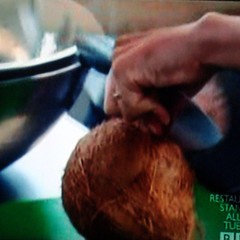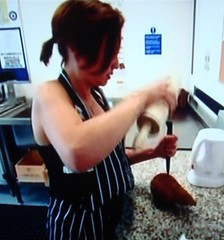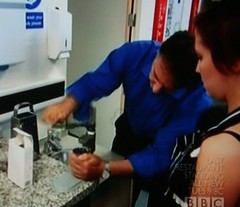 BBC America runs a series called Last Restaurant Standing, which is a rebroadcast of the BBC Two reality series The Restaurant. The premise of the show is simple: a number of couples are given "trial restaurants" to run as they compete for the chance to own a "permanent" restaurant in partnership with French chef Raymond Blanc; over the course of the series couples are eliminated via challenges and assignments until one couple remains and open their establishment. The first two series were captivating - the contestants were a mix of professional workers in the restaurant or hospitality industry and talented, passionate amateurs. It was fascinating to see them face the problems M. Blanc presented to them. Occasionally, circumstances conspired against the contestants, but more often than not they were their own worst enemies.
BBC America runs a series called Last Restaurant Standing, which is a rebroadcast of the BBC Two reality series The Restaurant. The premise of the show is simple: a number of couples are given "trial restaurants" to run as they compete for the chance to own a "permanent" restaurant in partnership with French chef Raymond Blanc; over the course of the series couples are eliminated via challenges and assignments until one couple remains and open their establishment. The first two series were captivating - the contestants were a mix of professional workers in the restaurant or hospitality industry and talented, passionate amateurs. It was fascinating to see them face the problems M. Blanc presented to them. Occasionally, circumstances conspired against the contestants, but more often than not they were their own worst enemies.And so it was that when the third series arrived in the US on BBC America, my family and I were eagerly anticipating it. We all watch Last Restaurant Standing together, chatting and laughing and occasionally slapping our foreheads at the successes and failures of the people chasing their dreams. But this season seems different than the previous two.
For one thing, there are fewer challenges. And here it is, Week 2, and the contestants haven't even been assigned their trial restaurants yet. But worse yet, the caliber of contestants is shockingly low. We expect some lack of experience among the hopefuls, but this time there seems to be a level of actual incompetence involved.
On the premier episode of the lastest season, each couple was asked to prepare a "signature dish" for Raymond and his judges. One couple, a mother-daughter team named Sandy and Natalie, decided that their signature dish would be fresh fruit with a coconut mousse. From the instant they hit the kitchen and tried to open their coconut, it was clear that these two had no business competing to run a restaurant.

Attempt No. 1: It is important that they catch every drop of coconut milk for their mousse, so obviously the best way to crack the coconut is to do it inside a stainless steel bowl. At left, Sandy looks on as Natalie gets to work - holding a chef's knife by the blade, she hammers the back of the knife with a rolling pin in an effort to split the shell.


Attempt No. 2 (above): Apparently, the bowl was not a very stable platform for hacking through the shell of a coconut, so Natalie decided to try a slightly different approach. Sandy carefully steadied the coconut while Natalie lined up the chef's knife (again, holding it by the blade) and whacked at it with the rolling pin. The level of risk and stupidity involved here isn't quite clear in the screen capture on the left above, so I also added the closeup on the right to properly display Natalie's blade-gripping technique.
 Attempt No. 3: Natalie decides that the chef's knife is the wrong tool for the job, so she changes over to a paring knife. She gets a good strong grip on the blade of the knife - wrapping her fist around the blade and part of the handle) and begins beating on the butt of the knife with that trusty rolling pin. After several tries, she finally gives up and lets Sandy try on her own.Sandy , displaying somewhat more common sense than her daughter, leaves the knife behind and just pounds on the coconut with the rolling pin until it splits open. Hooray! Now they can finally continue with the recipe!
Attempt No. 3: Natalie decides that the chef's knife is the wrong tool for the job, so she changes over to a paring knife. She gets a good strong grip on the blade of the knife - wrapping her fist around the blade and part of the handle) and begins beating on the butt of the knife with that trusty rolling pin. After several tries, she finally gives up and lets Sandy try on her own.Sandy , displaying somewhat more common sense than her daughter, leaves the knife behind and just pounds on the coconut with the rolling pin until it splits open. Hooray! Now they can finally continue with the recipe!
 Attempt No. 3: Natalie decides that the chef's knife is the wrong tool for the job, so she changes over to a paring knife. She gets a good strong grip on the blade of the knife - wrapping her fist around the blade and part of the handle) and begins beating on the butt of the knife with that trusty rolling pin. After several tries, she finally gives up and lets Sandy try on her own.Sandy , displaying somewhat more common sense than her daughter, leaves the knife behind and just pounds on the coconut with the rolling pin until it splits open. Hooray! Now they can finally continue with the recipe!
Attempt No. 3: Natalie decides that the chef's knife is the wrong tool for the job, so she changes over to a paring knife. She gets a good strong grip on the blade of the knife - wrapping her fist around the blade and part of the handle) and begins beating on the butt of the knife with that trusty rolling pin. After several tries, she finally gives up and lets Sandy try on her own.Sandy , displaying somewhat more common sense than her daughter, leaves the knife behind and just pounds on the coconut with the rolling pin until it splits open. Hooray! Now they can finally continue with the recipe!

Above: Natalie once again demonstrates her mad chef knife skillz by attempting to open a can of sweetened condensed milk using the "rolling pin plus handheld knife" technique. By this time, Raymond Blanc is sufficiently horrified to step in and demonstrate the use of a bench-mounted can opener.
I was surprised (and a little disappointed) that Natalie didn't open her hand instead of the tin of milk.
Natalie and Sandy's mousse was a disaster. They served it in a martini glass, and by the time it was brought out for the tasting, it was runny and starting to separate. Raymond took a taste and actually spit it into a napkin - the first time I've ever seen him do that with any food a contestant presented to him - and immediately told them that, thanks to the horrible quality of the dessert and the terrifying knife handling they had demonstrated in the kitchen, that they "must leave now."
Wow. Where the hell did the BBC find these people? And don't they have some sort of screening process? It's pretty obvious that the standards are going to be a bit lower in Series 3. In previous seasons, we watched the show and enjoyed the process that the contestants went through as they learned the ins and outs of the restaurant business. This time, I think we'll be watching for the trainwrecky lulz.
Check out Last Restaurant Standing Tuesdays at 8 pm on BBC America.
.
I was surprised (and a little disappointed) that Natalie didn't open her hand instead of the tin of milk.
Natalie and Sandy's mousse was a disaster. They served it in a martini glass, and by the time it was brought out for the tasting, it was runny and starting to separate. Raymond took a taste and actually spit it into a napkin - the first time I've ever seen him do that with any food a contestant presented to him - and immediately told them that, thanks to the horrible quality of the dessert and the terrifying knife handling they had demonstrated in the kitchen, that they "must leave now."
Wow. Where the hell did the BBC find these people? And don't they have some sort of screening process? It's pretty obvious that the standards are going to be a bit lower in Series 3. In previous seasons, we watched the show and enjoyed the process that the contestants went through as they learned the ins and outs of the restaurant business. This time, I think we'll be watching for the trainwrecky lulz.
Check out Last Restaurant Standing Tuesdays at 8 pm on BBC America.
.

2 comments:
You know...I've only seen the recap of one of the series, I think the second one. I didn't know what it was but I was very pleasantly surprised by it. It was a great recap of the entire contest with flashbacks and commentary. These type of shows can be hit or miss depending of course on the personalities involved. I always find them hard to watch in the beginning only because I don't have a sense for each competitor and there are usually a few that I don't care for and would rather not watch.
Once all the rif-raf are out...which I assume the unskilled mother-daughter team you mention will go shortly, then the shows tend to pick up speed and you can root for your favorites.
Question...is is the year's series maybe "Americanized" in away small form? Maybe dumbed down a little?
Sandy and Natalie were cut (no pun intended) before the end of the first show, so we'll be denied the spectacle of an extended crash and burn. But there are other, less dramatic, trainwrecks waiting to happen in this series I am sure.
Other than the name change for the American market, the BBC only makes one other adjustment for US viewers: They subtitle Raymond Blanc, which is not done for UK audiences. Other than that, there are no edits or modifications made for the US market.
Post a Comment